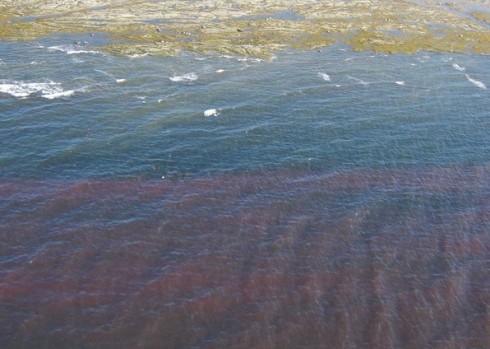In an interview with Whales Online, phytoplankton ecology researcher Michel Starr from Fisheries and Oceans Canada answers the following question: What was learned from the exceptional red tide (article in French only) in August 2008, which caused the death of thousands of fish, 591 birds, 85 seals, 10 belugas, 7 porpoises and a young fin whale?

Michel Starr: The research article Multispecies Mass Mortality of Marine Fauna Linked to a PST-Producing Algal Bloom that I co-authored is the first one in which a multi-species mortality event related to a red tide is described in detail. Mortality events associated with algal blooms producing paralytic neurotoxins are poorly documented natural phenomena because the evidence is difficult to collect, but we managed to do just that.
Whales Online: Why is it so difficult to document?
M.S.: Establishing a direct link between a toxic algal bloom, their toxins and the death of an organism is not so straightforward. Even if the algae in question, Alexandrium tamarense, produce a toxin that can cause respiratory failure in high concentrations, a veterinarian performing a necropsy on the carcass would not see anything abnormal. Only with advanced tissue analyses, especially in the liver, can one sometimes observe contamination. The 2008 episode was very closely monitored, thanks in part to the Quebec Marine Mammal Emergency Response Network. Notably, valuable data were obtained as part of the beluga carcass recovery program. We were able to analyze the entire food chain, and the article we wrote allows us to show the levels of contaminants at each link in the chain.
Additionally, our research was the first to document the transfer of toxins between mother seals and their fetuses. Indeed, samples were taken from pregnant female carcasses, and even the fetuses showed traces of paralytic phycotoxin.
WOL: Is it possible that other red tides of this magnitude might occur?
M.S.: Yes. In fact, the frequency, magnitude and geographic extent of red tides are increasing throughout the world. A number of factors favour Alexandrium tamarense, such as climate change that increases water temperatures, water stratification, and the frequency of heavy rainfall episodes. Eutrophication (excess of certain nutrients in a given area) in coastal waters, ballast water carried by ships or aquaculture (even if this is not an issue at the present time in the St. Laurence) are also factors conducive to the increase of toxic algae.
WOL: What can we do to prevent another red tide from occurring?
M.S.: Delaying climate change will not be easy. On the other hand, one area where everyone can pitch in is to limit fertilizers, both in agriculture and in one’s backyard. Through runoff, these products find their way into the river and contribute to the eutrophication of the water. Research is also being conducted on the possibility of controlling nitrogen discharges, as is already being done for phosphorus.
WOL: If an outbreak were to occur this summer, would it be possible to stop it?
M.S.: Currently, there is not much that can be done when an outbreak occurs. An experimental method involves adding mud to the water to break up the Alexandrium tamarense cells. On the other hand, the cells will encyst and sink to the sea floor and could re-emerge when conditions become favourable again. Prevention is therefore better than cure.
Reminder:
+The outbreak of Alexandrium tamarense, a single-celled dinoflagellate naturally present in the St. Lawrence ecosystem, occurred in early August 2008.
+The carcasses of thousands of fish, 591 birds, 85 seals, 10 belugas, 7 porpoises and 1 fin whale were found.
+Red tides are a natural phenomenon, but human activities can increase their frequency, intensity and geographic extent.
To read the research paper:
- Starr, S. Lair, S. Michaud, M. Scarratt, M. Quilliam, D. Lefaivre, et al. (2017) Multispecies Mass Mortality of Marine Fauna Linked to a PST-Producing Algal Bloom. PLoS ONE 12(5): e0176299.
On Whales Online:
+ A Red Tide Mobilizes Marine Mammal Emergencies (in French only)
+ How Can Microscopic Algae Kill a 45-tonne Whale?







